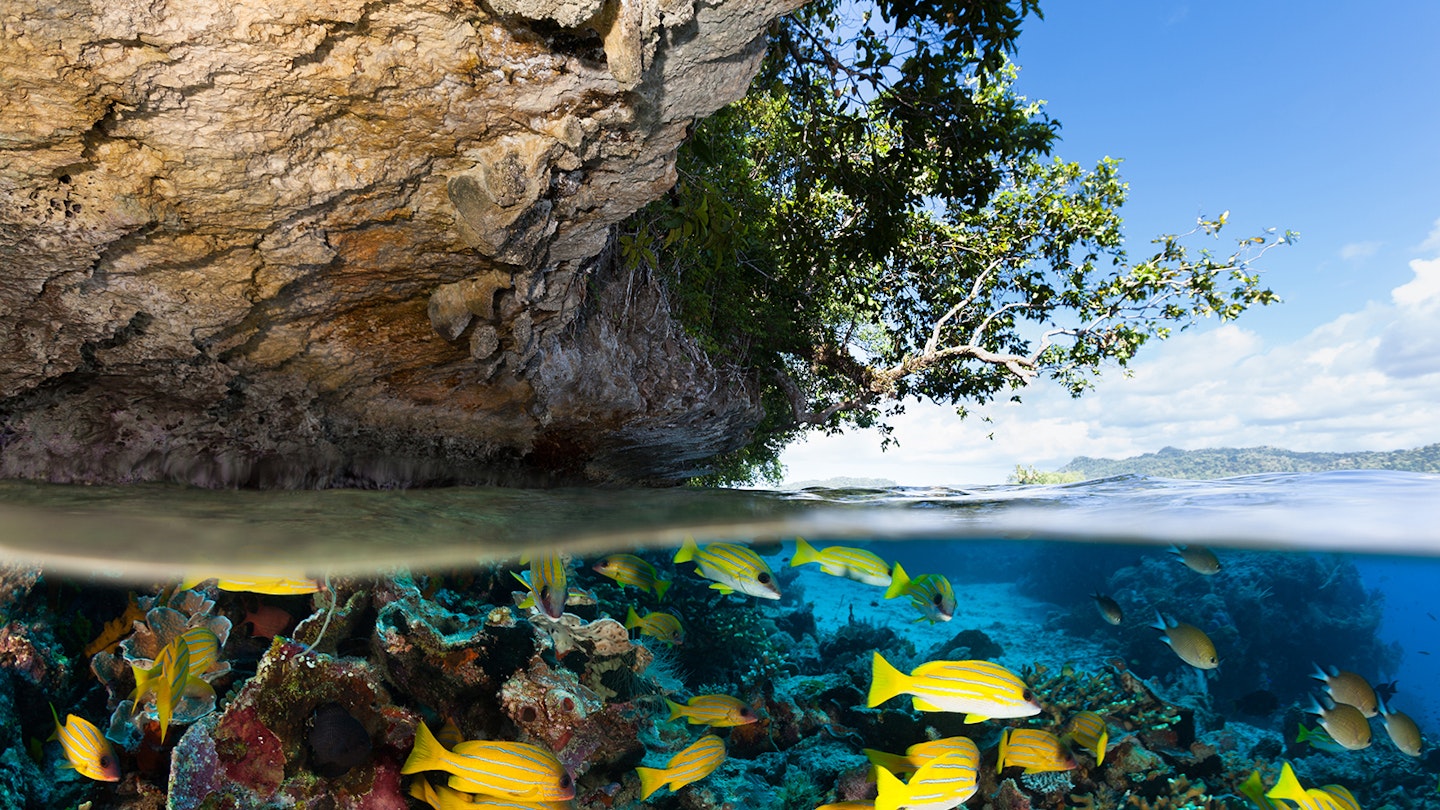Raja Ampat: The Ultimate Tropical Paradise
Picture a tropical archipelago of steep, jungle-covered islands, glittering white-sand beaches, hidden lagoons, and luminous turquoise waters. Now throw in pristine coral reefs inhabited by clouds of tie-dyed fish. Place it in a remote corner of Indonesia largely unknown to foreign tourists, and you end up with the Raja Ampat islands: the ultimate tropical paradise.

Why Go?
It’s a bold claim, but the collection of over 1500 islands and islets scattered off the northwest tip of Indonesian Papua that comprise Raja Ampat is truly one of Southeast Asia’s most beautiful archipelagos. If that isn’t sufficient motivation to place Raja Ampat onto your travel itinerary, consider the diving opportunities, which many experts tout as among the best globally.
Until recently, Raja Ampat was little-known outside hardcore off-the-beaten-track travel circles. However, its vast, largely untouched coral reef systems and incredible marine diversity are a diver’s dream. This region, nestled in the heart of the Coral Triangle, has been described by scientists as a ‘species factory,’ boasting over ten times the number of hard coral species found in the Caribbean.

When to Go
Raja Ampat is a year-round destination; however, many diving outfits pause operations between July and September due to the typically calm seas becoming quite rough. For the calmest waters and optimal visibility for diving, plan your visit between November and March. It’s important to note that the region experiences its heaviest rainfall from May to October, which can make jungle treks more challenging.

Diving and Snorkelling
Offering over 200 pristine diving locations, Raja Ampat dazzles everyone lucky enough to dip below the surface, revealing a vibrant array of fish and corals. On a single dive, expect encounters with majestic manta rays and giant clams, schools of barracuda, fusiliers, and parrotfish, tiny pygmy seahorses, and striking nudibranchs. Furthermore, with some luck, divers may spot elusive wobbegong and epaulette (walking) sharks. The marine topography varies from vertical walls and pinnacles to expansive reef flats and underwater ridges, creating unique diving experiences for all.
Raja Ampat is generally more suited to advanced divers, making it less ideal for beginners. Nevertheless, there are dive spots available for less experienced adventurers. Most dives involve drift diving, which can present strong currents along the edges of the reefs. Consequently, valid dive cards and proof of insurance are mandatory with reputable dive operators, most of whom provide all necessary diving equipment.

While the underwater abundance is impressive, some reefs in Raja Ampat stand out more than others. At Manta Sandy between Mansuar and Arborek islands, you’ll encounter huge manta rays, some spanning over 5 meters, waiting above large coral heads to be cleaned. Moreover, the Sardine Reef, 4 kilometers northeast of Pulau Kri, descends to 33 meters and teems with fish, often creating a quite dark underwater landscape! The vibrant interplay of fish and coral has made it a favorite among underwater photographers. Despite previous coral damage from a grounded cruise ship, the waters around Pulau Kri still host some of the most celebrated dive spots. Schools of barracuda, jackfish, batfish, and snapper cohabit with smaller reef fish, rays, sharks, turtles, and groupers, showcasing undamaged coral of breathtaking beauty.

Beyond the Reef
Raja Ampat isn’t solely for diving enthusiasts. The forested islands provide a habitat for two species of bird-of-paradise (the red and the Wilson’s), which can both be spotted on Waigeo and Batanta islands. Additionally, the islands are teeming with lizards, snakes, tortoises, opossums, and diverse birdlife. Almost every dive lodge and homestay can arrange pre-dawn tours that transport you to forest hideouts for bird-of-paradise ‘concert arenas.’ Most homestays also facilitate visits to local villages, pearl farms, and cave systems, as well as provide hiking guides.

Where to Stay
Accommodation options in Raja Ampat can be classified into three categories. For beach lovers who enjoy lounging under the palms and engaging in a bit of casual snorkelling, the increasing number of homestays are ideal—Pulau Kri and Pulau Gam notably offer excellent choices. Many of these homestays also provide diving opportunities, but safety standards and equipment maintenance can vary.
For dedicated divers, numerous quality dive resorts are available that typically offer one- to two-week packages, including transfers, meals, and a couple of daily dives. Top resorts include Raja Ampat Biodiversity (rajaampatbiodiversity.com) and Kri Eco Resort ((papua-diving.com/kri-eco-resort)). Lastly, liveaboard dive boats, such as Grand Komodo (komodoalordive.com), function as floating dive resorts that sail from one coral reef to another. Some itineraries even combine Raja Ampat with the neighboring Banda Islands of Maluku.
How to Get There
The nearest major airport to the Raja Ampat islands is located in the mainland city of Sorong. This airport receives flights from cities such as Jakarta, Pulau Ambon (Maluku), Jayapura (Papua), Manado, and Makassar (Sulawesi). From Sorong, a short ferry ride will take you to Waisai on the island of Waigeo, where homestay operators will be ready to pick you up. Most top-tier dive resorts and liveaboards also provide pick-up services from Sorong.
Getting to and from accommodations in Raja Ampat typically involves speedboat transfers (offered by all accommodation options), necessitating some planning; therefore, it is recommended to arrange accommodation and transfers beforehand. Keep in mind that prices for everything in Raja Ampat are significantly higher than those in Java, Bali, Sumatra, and other more popular Indonesian tourist destinations.
This article was first published in February 2016 and is current as of May 2017.





